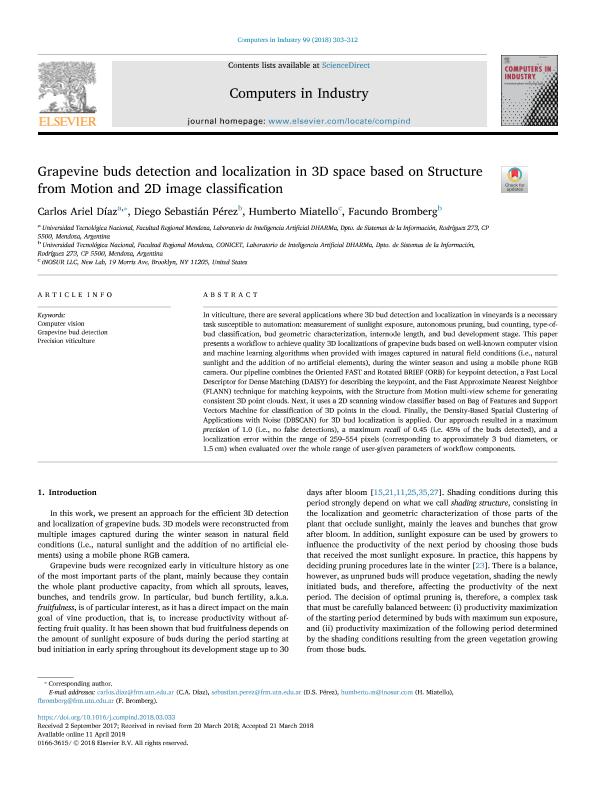Mostrar el registro sencillo del ítem
dc.contributor.author
Díaz, Carlos Ariel

dc.contributor.author
Pérez, Diego Sebastián

dc.contributor.author
Miatello, Humberto
dc.contributor.author
Bromberg, Facundo

dc.date.available
2020-03-20T16:14:09Z
dc.date.issued
2018-08
dc.identifier.citation
Díaz, Carlos Ariel; Pérez, Diego Sebastián; Miatello, Humberto; Bromberg, Facundo; Grapevine buds detection and localization in 3D space based on Structure from Motion and 2D image classification; Elsevier Science; Computers In Industry; 99; 8-2018; 303-312
dc.identifier.issn
0166-3615
dc.identifier.uri
http://hdl.handle.net/11336/100405
dc.description.abstract
In viticulture, there are several applications where 3D bud detection and localization in vineyards is a necessary task susceptible to automation: measurement of sunlight exposure, autonomous pruning, bud counting, type-of-bud classification, bud geometric characterization, internode length, and bud development stage. This paper presents a workflow to achieve quality 3D localizations of grapevine buds based on well-known computer vision and machine learning algorithms when provided with images captured in natural field conditions (i.e., natural sunlight and the addition of no artificial elements), during the winter season and using a mobile phone RGB camera. Our pipeline combines the Oriented FAST and Rotated BRIEF (ORB) for keypoint detection, a Fast Local Descriptor for Dense Matching (DAISY) for describing the keypoint, and the Fast Approximate Nearest Neighbor (FLANN) technique for matching keypoints, with the Structure from Motion multi-view scheme for generating consistent 3D point clouds. Next, it uses a 2D scanning window classifier based on Bag of Features and Support Vectors Machine for classification of 3D points in the cloud. Finally, the Density-Based Spatial Clustering of Applications with Noise (DBSCAN) for 3D bud localization is applied. Our approach resulted in a maximum precision of 1.0 (i.e., no false detections), a maximum recall of 0.45 (i.e. 45% of the buds detected), and a localization error within the range of 259–554 pixels (corresponding to approximately 3 bud diameters, or 1.5 cm) when evaluated over the whole range of user-given parameters of workflow components.
dc.format
application/pdf
dc.language.iso
eng
dc.publisher
Elsevier Science

dc.rights
info:eu-repo/semantics/openAccess
dc.rights.uri
https://creativecommons.org/licenses/by-nc-sa/2.5/ar/
dc.subject
COMPUTER VISION
dc.subject
GRAPEVINE BUD DETECTION
dc.subject
PRECISION VITICULTURE
dc.subject.classification
Ciencias de la Computación

dc.subject.classification
Ciencias de la Computación e Información

dc.subject.classification
CIENCIAS NATURALES Y EXACTAS

dc.title
Grapevine buds detection and localization in 3D space based on Structure from Motion and 2D image classification
dc.type
info:eu-repo/semantics/article
dc.type
info:ar-repo/semantics/artículo
dc.type
info:eu-repo/semantics/publishedVersion
dc.date.updated
2020-03-20T13:11:03Z
dc.journal.volume
99
dc.journal.pagination
303-312
dc.journal.pais
Países Bajos

dc.journal.ciudad
Amsterdam
dc.description.fil
Fil: Díaz, Carlos Ariel. Universidad Tecnológica Nacional. Facultad Regional Mendoza. Departamento de Sistemas de Información. Laboratorio DHARMA; Argentina
dc.description.fil
Fil: Pérez, Diego Sebastián. Universidad Tecnológica Nacional. Facultad Regional Mendoza. Departamento de Sistemas de Información. Laboratorio DHARMA; Argentina. Consejo Nacional de Investigaciones Científicas y Técnicas. Centro Científico Tecnológico Conicet - Mendoza; Argentina
dc.description.fil
Fil: Miatello, Humberto. New Lab; Estados Unidos
dc.description.fil
Fil: Bromberg, Facundo. Universidad Tecnológica Nacional. Facultad Regional Mendoza. Departamento de Sistemas de Información. Laboratorio DHARMA; Argentina. Consejo Nacional de Investigaciones Científicas y Técnicas. Centro Científico Tecnológico Conicet - Mendoza; Argentina
dc.journal.title
Computers In Industry

dc.relation.alternativeid
info:eu-repo/semantics/altIdentifier/url/https://www.sciencedirect.com/science/article/abs/pii/S0166361517304815
dc.relation.alternativeid
info:eu-repo/semantics/altIdentifier/doi/http://dx.doi.org/10.1016/j.compind.2018.03.033
Archivos asociados
